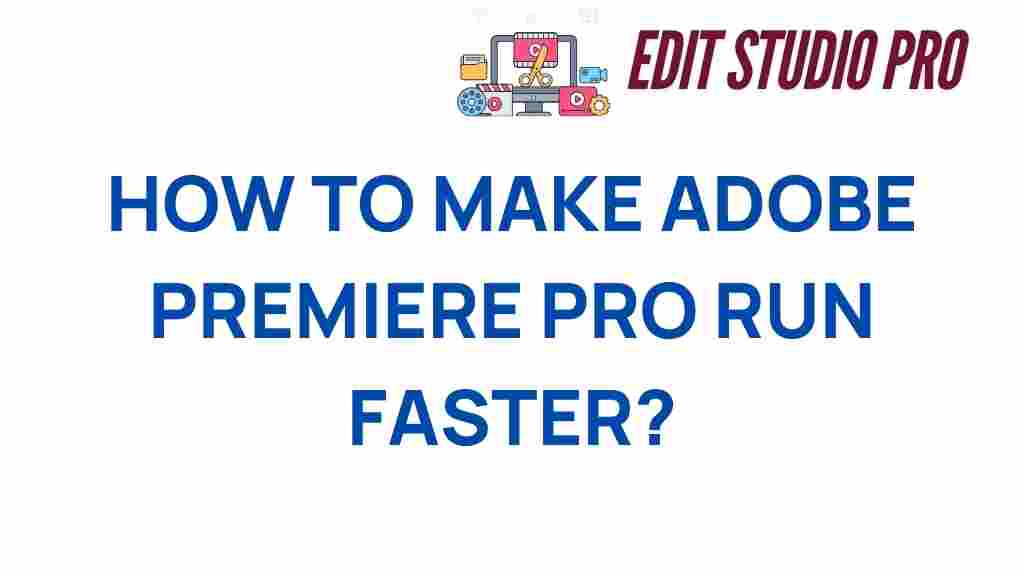Unlocking Speed: How to Make Adobe Premiere Pro Run Faster
Adobe Premiere Pro is a powerful tool for video editing, but many users encounter performance issues that can slow down their workflow. If you’re looking to improve your editing speed and optimize your software, you’ve come to the right place. This guide will provide essential performance tips, workflow improvement strategies, and productivity hacks to make Adobe Premiere Pro run faster, ensuring you can focus on your creativity rather than waiting for your software to catch up.
Understanding Adobe Premiere Pro Performance
Before diving into the tips, it’s important to understand what affects the performance of Adobe Premiere Pro. Factors such as your computer’s hardware, the complexity of your project, and the settings within the software can all impact editing speed. Below are some common areas to consider:
- Hardware Specifications: CPU, RAM, GPU, and storage type can significantly influence performance.
- Project Complexity: High-resolution videos, multiple effects, and large files can slow down processing.
- Software Settings: Optimizing settings can lead to faster rendering and playback.
Step-by-Step Performance Optimization for Adobe Premiere Pro
Now that we understand the basics, let’s explore specific performance tips to enhance your Adobe Premiere Pro experience:
1. Upgrade Your Hardware
Your editing speed can be dramatically improved with the right hardware. Consider upgrading:
- CPU: A faster processor can handle more tasks simultaneously, improving overall performance.
- RAM: Increasing your RAM allows for smoother operations, especially with high-resolution projects. Aim for at least 16GB for basic tasks, and 32GB or more for intensive editing.
- GPU: A dedicated graphics card can accelerate rendering and playback, especially when using effects.
- Storage: Use SSDs instead of HDDs for faster file access speeds.
2. Optimize Project Settings
Adjusting your project settings can make a significant difference in performance:
- Sequence Settings: Match your sequence settings to your footage. If you’re editing in 4K, create a 4K sequence to avoid unnecessary scaling.
- Playback Resolution: Lower the playback resolution to 1/2 or 1/4 during editing to improve responsiveness.
- Render Effects: Pre-render effects for smoother playback. Select the clips and go to Sequence > Render In to Out.
3. Manage Media Files Efficiently
Organizing your media can streamline your workflow:
- Use Proxies: Create lower-resolution proxy files for editing, which can significantly speed up playback and editing.
- Organize Files: Maintain a clean project panel with well-organized bins for easy access to assets.
- Delete Unused Media: Regularly clean your project by removing unused media files to reduce clutter and enhance performance.
4. Optimize Adobe Premiere Pro Preferences
Adjusting your preferences can lead to better performance:
- Memory Usage: Allocate more RAM to Adobe Premiere Pro in the preferences menu.
- Media Cache: Set your media cache to a fast SSD and regularly clean it to prevent slowdowns.
- Playback Settings: Enable GPU Acceleration if supported by your hardware for more efficient rendering.
5. Streamline Your Workflow
Improving your workflow can also enhance productivity:
- Keyboard Shortcuts: Learn and customize keyboard shortcuts for frequently used tools and commands.
- Use Templates: Save time by creating and using project templates for common tasks.
- Batch Processing: When exporting, use batch processing to handle multiple projects at once.
Troubleshooting Performance Issues
Even with all the optimizations, you might still face performance issues. Here are some troubleshooting tips:
- Check for Software Updates: Ensure you are running the latest version of Adobe Premiere Pro to benefit from performance improvements and bug fixes.
- Close Unnecessary Applications: Free up system resources by closing other applications while editing.
- Use Task Manager: Monitor your system’s resource usage to identify bottlenecks.
Additional Productivity Hacks for Adobe Premiere Pro
Here are some productivity hacks to consider that can further improve your editing experience:
- Utilize Creative Tools: Explore Adobe’s suite of creative tools, such as After Effects and Audition, to enhance your projects.
- Color Grading and Effects: Use built-in effects and color grading tools to streamline the creative process without needing additional software.
- Collaborate with Team Members: Utilize Adobe Creative Cloud for seamless collaboration with team members, allowing for real-time feedback and edits.
Conclusion
By implementing these performance tips and optimization strategies, you can unlock the true potential of Adobe Premiere Pro and elevate your video editing experience. From upgrading hardware to fine-tuning your software preferences, every adjustment counts toward improving your editing speed and overall productivity.
Remember, the key to efficient video editing lies in maintaining a balance between creativity and technical efficiency. Take the time to optimize your workflow, and you will not only see improvements in performance but also enjoy a more fluid and enjoyable editing process.
For more tips on video editing, check out this comprehensive guide. If you’re interested in exploring Adobe Premiere Pro’s features further, visit the official Adobe website.
This article is in the category Tips & Tricks and created by EditStudioPro Team
